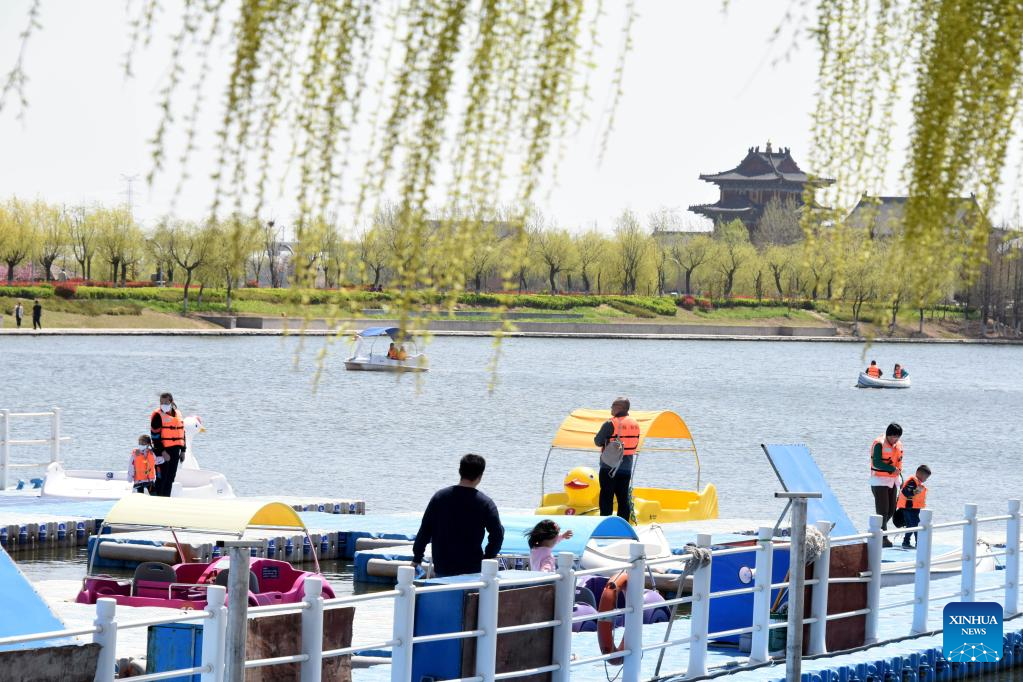[ad_1]

This aerial photo taken on April 14, 2023 shows the Jiaozhou Bay Bridge in Qingdao, east China’s Shandong Province. (Xinhua/Li Ziheng)
JINAN, May 5 (Xinhua) — Jiaozhou Bay in east China’s Shandong Province is among the country’s first to carry out comprehensive and systematic marine ecological surveys.
“We’ve observed the bay’s environment since the 1980s and set up 14 long-term monitoring spots here. Starting from 2003, our monitoring frequency has increased to once a month, covering the major ecological areas of Jiaozhou Bay,” said Sun Xiaoxia, a researcher at the Institute of Oceanography under the Chinese Academy of Sciences.
Over the past four decades, the bay, in the coastal city of Qingdao, has witnessed tremendous progress in its ecological environment preservation. Thanks to a series of eco-friendly policies and restoration efforts, the local government has continuously improved the bay’s environmental health and recovered the aquatic plant population.
“The health of the bay’s ecosystem has been steadily recovering since 2003, reaching its historical best over the past two decades in 2021,” Sun said.
Liu Song, born in 1990, has lived at the bay since her childhood. She has taken over a family seafood business, farming clams and sea cucumbers.
Hailing from a family that relies on the local marine ecosystem, Liu knows better than many others about the ecological changes of Jiaozhou Bay over the years.
“The quality of our local specialty, Hongdao clams, is good nowadays, but back in 2000, due to poor water quality, clam quality was far inferior to what it is now,” Liu recalled.
“Sea cucumber farming has also benefited from the improving water quality in Jiaozhou Bay,” Liu added.
According to the Qingdao municipal ecology and environment bureau, the proportion of waters with excellent quality in Qingdao’s offshore areas has come in at 99 percent, indicating continuous improvement of the local marine environment.
Such ecological progress is hard-won.
In the 1990s, as Qingdao was accelerating its urbanization, the amount of wastewater discharge ballooned, worsening Jiaozhou Bay’s pollution situation.
Fortunately, the municipal government took timely environmental protection measures including building sewage treatment plants, riverway dredging and remediation, and wetland restoration, while also strengthening their law enforcement efforts to ensure orderly marine resource exploitation and proper pollution treatment.
Zhao Mei, head of a local sewage treatment company, said that her company has spent more than 10 million yuan (about 1.44 million U.S. dollars) on upgrading its equipment. Currently, the treated wastewater is used for landscaping irrigation and road cleaning.
Sun Xiaoxia said that since the beginning of the 21st century, the biomass of plankton in Jiaozhou Bay has posted an obvious increase, multiplying 2.54 times compared to that of the 1990s.
Li Xinzheng, a researcher at the Institute of Oceanography, also attributed the rising average biomass and density of large benthic organisms in or near the bay to the complete ban on all forms of trawling and the implementation of relevant fishing moratorium policies in Jiaozhou Bay.
“The successful governance of Jiaozhou Bay’s ecological environment has become a model for China’s marine ecological governance and a typical achievement of the country’s sustainable development and utilization of its coastal waters,” said Sun.

Tourists have fun at a park in Qingdao, east China’s Shandong Province, April 8, 2023. (Xinhua/Li Ziheng)

This photo taken on April 14, 2023 shows the Jiaozhou Bay Bridge in Qingdao, east China’s Shandong Province. (Xinhua/Li Ziheng)
(Web editor: Zhang Kaiwei, Liang Jun)
[ad_2]
Source link



